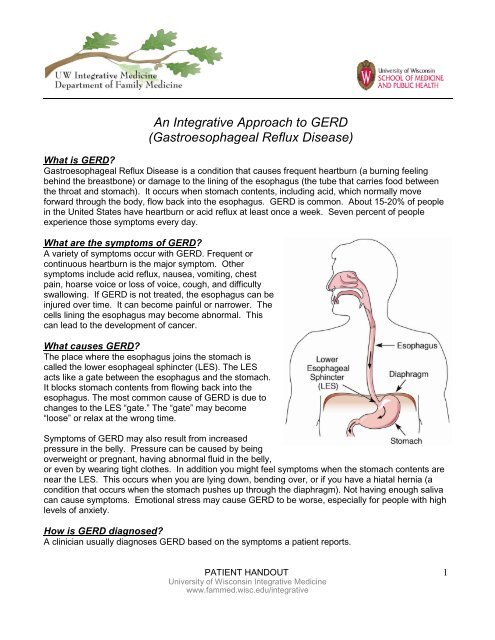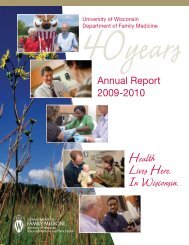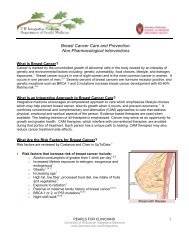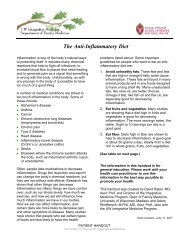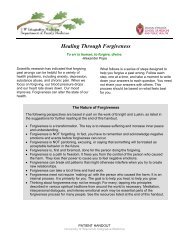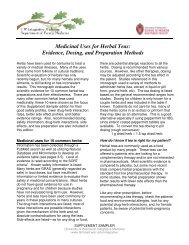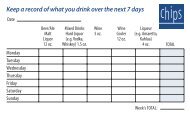An Integrative Approach to GERD - UW Family Medicine - University ...
An Integrative Approach to GERD - UW Family Medicine - University ...
An Integrative Approach to GERD - UW Family Medicine - University ...
Create successful ePaper yourself
Turn your PDF publications into a flip-book with our unique Google optimized e-Paper software.
<strong>An</strong> <strong>Integrative</strong> <strong>Approach</strong> <strong>to</strong> <strong>GERD</strong>(Gastroesophageal Reflux Disease)What is <strong>GERD</strong>?Gastroesophageal Reflux Disease is a condition that causes frequent heartburn (a burning feelingbehind the breastbone) or damage <strong>to</strong> the lining of the esophagus (the tube that carries food betweenthe throat and s<strong>to</strong>mach). It occurs when s<strong>to</strong>mach contents, including acid, which normally moveforward through the body, flow back in<strong>to</strong> the esophagus. <strong>GERD</strong> is common. About 15-20% of peoplein the United States have heartburn or acid reflux at least once a week. Seven percent of peopleexperience those symp<strong>to</strong>ms every day.What are the symp<strong>to</strong>ms of <strong>GERD</strong>?A variety of symp<strong>to</strong>ms occur with <strong>GERD</strong>. Frequent orcontinuous heartburn is the major symp<strong>to</strong>m. Othersymp<strong>to</strong>ms include acid reflux, nausea, vomiting, chestpain, hoarse voice or loss of voice, cough, and difficultyswallowing. If <strong>GERD</strong> is not treated, the esophagus can beinjured over time. It can become painful or narrower. Thecells lining the esophagus may become abnormal. Thiscan lead <strong>to</strong> the development of cancer.What causes <strong>GERD</strong>?The place where the esophagus joins the s<strong>to</strong>mach iscalled the lower esophageal sphincter (LES). The LESacts like a gate between the esophagus and the s<strong>to</strong>mach.It blocks s<strong>to</strong>mach contents from flowing back in<strong>to</strong> theesophagus. The most common cause of <strong>GERD</strong> is due <strong>to</strong>changes <strong>to</strong> the LES “gate.” The “gate” may become“loose” or relax at the wrong time.Symp<strong>to</strong>ms of <strong>GERD</strong> may also result from increasedpressure in the belly. Pressure can be caused by beingoverweight or pregnant, having abnormal fluid in the belly,or even by wearing tight clothes. In addition you might feel symp<strong>to</strong>ms when the s<strong>to</strong>mach contents arenear the LES. This occurs when you are lying down, bending over, or if you have a hiatal hernia (acondition that occurs when the s<strong>to</strong>mach pushes up through the diaphragm). Not having enough salivacan cause symp<strong>to</strong>ms. Emotional stress may cause <strong>GERD</strong> <strong>to</strong> be worse, especially for people with highlevels of anxiety.How is <strong>GERD</strong> diagnosed?A clinician usually diagnoses <strong>GERD</strong> based on the symp<strong>to</strong>ms a patient reports.PATIENT HANDOUT 1<strong>University</strong> of Wisconsin <strong>Integrative</strong> <strong>Medicine</strong>www.fammed.wisc.edu/integrative
Gastroesophageal Reflux Disease1. LifestyleWhen <strong>GERD</strong> is mild, the first approach is <strong>to</strong> make changes in your lifestyle. This can improveor even eliminate symp<strong>to</strong>ms. For example, symp<strong>to</strong>ms may improve if smokers quit andobese patients lose weight. See Table 1 for a list of things that tend <strong>to</strong> cause the LES gate <strong>to</strong>become <strong>to</strong>o relaxed. Try <strong>to</strong> avoid them as much as possible. If you have symp<strong>to</strong>ms while inbed, raise the head of your bed four <strong>to</strong> six inches by using blocks under the bed posts. (Note:you can make <strong>GERD</strong> worse by using extra pillows <strong>to</strong> raise your head, because this mayincrease the pressure on your belly). Mela<strong>to</strong>nin is another possible helpful nighttime remedy.Mela<strong>to</strong>nin may help the LES work better. The dose is 2.5 milligrams. Small studies havefound a combination of mela<strong>to</strong>nin, vitamins and amino acids, either alone or along withprescription medication called pro<strong>to</strong>n pump inhibi<strong>to</strong>rs (PPIs), have helped people with <strong>GERD</strong>.More research is needed.FACTORTable 1: Fac<strong>to</strong>rs that Relax the LESEXAMPLESDietary supplementsFoods/BeveragesLifestyleMedicationsPhysicalTrauma/irritation/miscellaneousarginineherbs used for gas in the s<strong>to</strong>mach such aspeppermint and spearmintessential oils (high doses)alcoholchocolatecoffee (especially with caffeine)cow’s milkfa<strong>to</strong>range juicespicy foodstea<strong>to</strong>ma<strong>to</strong> juicesmokingCheck with your clinician about anymedications you take or plan <strong>to</strong> take.<strong>to</strong>o much acidafter mealss<strong>to</strong>mach contents not moving through bodya blockage between the s<strong>to</strong>mach and thesmall intestinered, irritated esophagusscleroderma-like diseases (causinghardening or thickening of body tissue)damage from surgeryPATIENT HANDOUT 3<strong>University</strong> of Wisconsin <strong>Integrative</strong> <strong>Medicine</strong>www.fammed.wisc.edu/integrative
Gastroesophageal Reflux Disease2. Nutrition and ExerciseBoth exercise and nutrition can reduce <strong>GERD</strong> symp<strong>to</strong>ms. If you have <strong>GERD</strong>, try <strong>to</strong> eliminatethe foods, drinks, and other substances listed in Table 1 for at least two weeks. Pay closeattention <strong>to</strong> your symp<strong>to</strong>ms. If your symp<strong>to</strong>ms improve, you can either 1) continue <strong>to</strong> avoidthese things, or 2) each week add a different food or item back in<strong>to</strong> your life. Watch closely <strong>to</strong>see if any of your symp<strong>to</strong>ms recur. See our handout <strong>GERD</strong> Elimination Diet for moreinformation.Diets high in fiber seem <strong>to</strong> decrease <strong>GERD</strong>. Most experts recommend eating fewer foodsthat contain cholesterol, saturated fatty acids, and <strong>to</strong>tal fat if you have <strong>GERD</strong>. Studies,however, have shown mixed results. It may be that heavier body weight, rather than fat in thediet per se, causes <strong>GERD</strong>. Studies also show mixed results regarding drinking alcohol orcoffee. Some studies found more <strong>GERD</strong> symp<strong>to</strong>ms with alcohol and coffee, some showedless, and others showed no difference.Regular activity is important for the health of your body and <strong>to</strong> aid indigesting your food. People who do physical activity regularly during theirleisure time seem <strong>to</strong> have fewer <strong>GERD</strong> symp<strong>to</strong>ms. It is better <strong>to</strong> exerciseduring leisure time rather than during the workday. This may be becausepeople are eating and exercising within a short span of time. Exercisingright after you eat increases your chance of developing <strong>GERD</strong>. Somepeople who exercise strenuously, especially running, weight lifting, and,cycling, may actually have an increase in <strong>GERD</strong>. This may be due <strong>to</strong>decreased blood flow in the digestive system, increased contractions ofthe esophagus, and more pressure on the LES.Charlene Luchterhand<strong>UW</strong>-Madison Integ. Med.3. Herbal <strong>Medicine</strong>Licorice. Some herbal medicines can be used <strong>to</strong> soothe and protect irritated tissues andpromote healing. Licorice (Glycyrrhiza glabra) is one example. It can be used for <strong>GERD</strong>,s<strong>to</strong>mach upset or pain, and ulcers. For long-term use, it should be prescribed asdeglycyrrhizinated licorice (DGL) in order <strong>to</strong> avoid side effects. A common dose is two <strong>to</strong>four 380 milligram lozenges before meals.Slippery Elm. Slippery elm (Ulmus fulva) root bark powder is also helpful for <strong>GERD</strong>. One<strong>to</strong> two tablespoons of the powder can be mixed with a glass of water and taken aftermeals and before bed. If you add <strong>to</strong>o much powder, it can become very thick and difficult<strong>to</strong> <strong>to</strong>lerate. You can sweeten it slightly with honey or sugar if you prefer. Slippery elmappears <strong>to</strong> be very safe. Avoid taking it at the same time as other medications. Its fibersmay bind <strong>to</strong> medications taken at the same time, and you will not get their full effect.Marshmallow. Marshmallow (Althea officinalis) (the herb, not the white fluffy sweet) canalso provide symp<strong>to</strong>m relief. It is helpful for sore throat, cough, bronchitis, and woundhealing. The usual dose is 5-6 grams daily, which is about 2-3 tablespoons. Make a teafrom the leaves or roots and drink it three times daily using 1 tablespoon (or less) ofmarshmallow each time. As with slippery elm, do not take it at the same time as otherdrugs or you may not get the full effect of your medications.PATIENT HANDOUT 4<strong>University</strong> of Wisconsin <strong>Integrative</strong> <strong>Medicine</strong>www.fammed.wisc.edu/integrative
Gastroesophageal Reflux DiseaseChamomile. Chamomile (Matricaria recituta) is well known for its ability <strong>to</strong> help peoplesleep and <strong>to</strong> calm the s<strong>to</strong>mach. In <strong>GERD</strong>, it fights inflammation (pain, redness, irritation).Chamomile is usually taken as a tea of 1-3 grams of the flowers, which is about onetablespoon. Steep them in a cup covered with a saucer. Drink the tea three <strong>to</strong> four timesdaily. Chamomile is generally well-<strong>to</strong>lerated, but if you are allergic <strong>to</strong> plants in the daisyfamily (Asteraceae), your allergy symp<strong>to</strong>ms may become worse when you drinkchamomile tea.Combination Botanical Products. Iberogast® includes acombination of Clown's mustard, German chamomile,angelica root, caraway, milk thistle, lemon balm, celandine,licorice root and peppermint leaf. A careful review of anumber of studies showed that it can be helpful for upsets<strong>to</strong>mach and can reduce pain, cramping, nausea andvomiting. The usual dose is one milliliter three times daily.Most people <strong>to</strong>lerate it well, but it can cause nausea,diarrhea and skin rash for some.© Bob S<strong>to</strong>ckfield Courtesy: NCCAM4. Pharmaceuticals<strong>An</strong>tacid medicines, including over-the-counter antacids and prescription medicines known asH 2 recep<strong>to</strong>r blockers (H2Bs) and pro<strong>to</strong>n pump inhibi<strong>to</strong>rs (PPIs), are commonly used <strong>to</strong> treat<strong>GERD</strong>. Both are helpful, but a recent review of many studies has shown that PPIs are moreeffective than H2Bs. A clinician also may prescribe a PPI for one week <strong>to</strong> help determine if apatient has <strong>GERD</strong>. The best time <strong>to</strong> take a PPI is 30 minutes before eating.Some clinicians prescribe H2Bs or PPIs as long as you need them <strong>to</strong> control symp<strong>to</strong>ms.<strong>An</strong>tacids try <strong>to</strong> wipe-out the acid in the s<strong>to</strong>mach, so that s<strong>to</strong>mach contents flowing back in<strong>to</strong>the esophagus no longer cause irritation or discomfort. However, this does not fix the problemwith the LES broken gate and can cause other concerns if these medicines are used for along time. Clinicians are becoming increasingly concerned about the long-term use of thismedication. It has been shown <strong>to</strong> interfere with digestion, increase the risk of infections, andpossibly increase the risk of s<strong>to</strong>mach cancer and fractures of the hip and spine.Tapering off a pro<strong>to</strong>n pump inhibi<strong>to</strong>rIt is a wise idea not <strong>to</strong> take a PPI any longer than you need <strong>to</strong>. Talk with your clinician if youhave made some changes <strong>to</strong> your diet and lifestyle and feel you no longer need themedication. It can be a bit tricky <strong>to</strong> discontinue a PPI, because you can have a reboundeffect. This means that s<strong>to</strong>mach acids can increase even if your condition has improved.Rebound symp<strong>to</strong>ms can last for 10-14 days. Here’s a plan <strong>to</strong> help you get through this periodwhile discontinuing the medication. Work with your clinician <strong>to</strong> make certain it is right for you.Plan1. Focus on nutrition. Try <strong>to</strong> avoid: alcohol, caffeine (e.g., coffee), chocolate, cow's milk,animal fat and orange juice.2. Follow your clinician’s directions <strong>to</strong> slowly taper off the PPI over 2-4 weeks (the higher thedose, the longer the taper).PATIENT HANDOUT 5<strong>University</strong> of Wisconsin <strong>Integrative</strong> <strong>Medicine</strong>www.fammed.wisc.edu/integrative
Gastroesophageal Reflux DiseaseTapering off a pro<strong>to</strong>n pump inhibi<strong>to</strong>r (con’t.)3. During this time, try the following:Get regular aerobic exercise.Practice a relaxation technique such as deep breathing. (This can aid in digestion andkeep food moving through your body. See our handout Breathing Exercise).Try acupuncture 1-2 times per weekAdd one or more of the following:o Deglycyrrhizinated Licorice (DGL), two-four 380 mg tablets before meals orSucralfate (Carafate) 1 gm before meals.o Slippery Elm, 1-2 tablespoons of powdered root in water or 400-500 mgcapsules or 5 milliliter of a tincture three <strong>to</strong> four times/daily.o Iberogast® 1 milliliter three times/daily (Can get from: Iberogast on Amazon)*4. If you are successful and are able <strong>to</strong> discontinue the PPI without symp<strong>to</strong>ms coming back,you can slowly taper off the licorice, slippery elm or Iberogast. Continue <strong>to</strong> watch whatyou eat, exercise and manage your stress. If symp<strong>to</strong>ms return, talk <strong>to</strong> your clinician aboutstarting licorice, slippery elm or Iberogast or an H2B medication. If symp<strong>to</strong>ms are stilldifficult <strong>to</strong> control, you may need <strong>to</strong> restart the PPI.5. Mind-body therapyStress can cause <strong>GERD</strong> symp<strong>to</strong>ms <strong>to</strong> be worse, especially forpeople who have a lot of anxiety. Relaxation training can improvesymp<strong>to</strong>ms. The following are links <strong>to</strong> some of our handouts thatprovide information about using mind-body techniques:Learning <strong>to</strong> Meditate (patient version)Breathing ExerciseUsing Journaling <strong>to</strong> Aid Health© Bob S<strong>to</strong>ckfieldCourtesy: NCCAM6. Traditional Chinese <strong>Medicine</strong> (TCM)TCM includes a combination of diet, lifestyle, herbal medicines, and acupuncture/acupressure. It can be used alone or with other treatments. One interesting study ofacupuncture for <strong>GERD</strong> found that adding acupuncture <strong>to</strong> PPI therapy was more effective thansimply doubling the dose of the PPI.7. SurgerySurgery is an option if other approaches do not work. The most common surgical procedureis the Nissen fundoplication. In this procedure the bot<strong>to</strong>m of the s<strong>to</strong>mach is wrapped wholly orpartially around the lower esophagus. This creates an area of high pressure meant <strong>to</strong> prevents<strong>to</strong>mach contents from entering in<strong>to</strong> the esophagus and causing symp<strong>to</strong>ms. The surgery canbe done through a large incision (open surgery) or through several small incisions(laparoscopic surgery).The laparoscopic approach is as effective as open surgery, and ahernia is less likely <strong>to</strong> develop at the scar with this approach.PATIENT HANDOUT 6<strong>University</strong> of Wisconsin <strong>Integrative</strong> <strong>Medicine</strong>www.fammed.wisc.edu/integrative
Gastroesophageal Reflux DiseaseSurgery (con’t.)One review examined health-related quality of life and <strong>GERD</strong> symp<strong>to</strong>ms after one year in fourstudies involving 1232 people. Some were treated medically; others had laparoscopicsurgery. Overall, the surgery seemed <strong>to</strong> improve symp<strong>to</strong>ms of <strong>GERD</strong> more than medicalmanagement. However, surgery is more costly, and people who have surgery may havemore difficulty swallowing following surgery than those who do not have surgery. One carefulreview of several studies found that the partial laparoscopic surgery resulted in fewerswallowing difficulties than the surgery involving the whole s<strong>to</strong>mach.The information in this handout is for general education. It is not meant <strong>to</strong> be used by apatient alone. Please work with your health care practitioner <strong>to</strong> use this information inthe best way possible <strong>to</strong> promote your health.*Neither the authors nor the university has any financial ties or conflict of interest regarding theproduct recommended in this handout.References, if needed, can be found in the clinician version of this handout.This handout was created by Charlene Luchterhand MSSW, Education/Research Coordina<strong>to</strong>r,Department of <strong>Family</strong> <strong>Medicine</strong>, <strong>University</strong> of Wisconsin-Madison School of <strong>Medicine</strong> and PublicHealth, adapted from a handout for clinicians by David Kiefer MD, Research Fellow, Departmen<strong>to</strong>f <strong>Family</strong> <strong>Medicine</strong>, <strong>University</strong> of Wisconsin-Madison School of <strong>Medicine</strong> and Public Health &Assistant Clinical Professor of <strong>Medicine</strong>, Arizona Center for <strong>Integrative</strong> <strong>Medicine</strong>, <strong>University</strong> ofArizona; David Rakel MD, Assoc. Professor & Direc<strong>to</strong>r of the <strong>University</strong> of Wisconsin-Madison<strong>Integrative</strong> <strong>Medicine</strong> Program, and Rian Podein MD, <strong>Family</strong> Physician, Mayo Clinic HealthSystem, Lake City, Minnesota.Notes:Date created: March, 2012PATIENT HANDOUT 7<strong>University</strong> of Wisconsin <strong>Integrative</strong> <strong>Medicine</strong>www.fammed.wisc.edu/integrative


